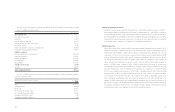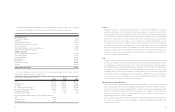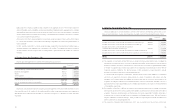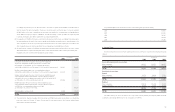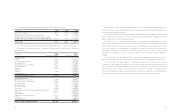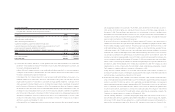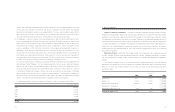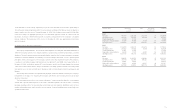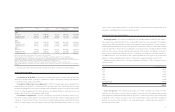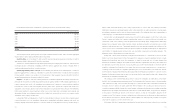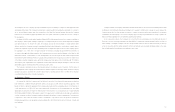LensCrafters 2003 Annual Report Download - page 61
Download and view the complete annual report
Please find page 61 of the 2003 LensCrafters annual report below. You can navigate through the pages in the report by either clicking on the pages listed below, or by using the keyword search tool below to find specific information within the annual report.
121120
vendor would not cause a significant impact on the future operations of the Company as it could replace this vendor
quickly with other third party and Company-manufactured products.
14 COMMITTMENTS AND CONTINGENCIES
Royalty Agreements - The Company is obligated under non-cancelable distribution agreements with designers,
which expire at various dates through 2013. In accordance with the provisions of such agreements, the Company is
required to pay royalties and advertising fees based on a percentage of sales (as defined) with, in certain agreements,
minimum guaranteed payments in each year of the agreements. In the first half of 2003, the Company has terminated
its license agreement for the production and distribution of the Giorgio Armani and Emporio Armani eyewear
collections and has signed a ten-year worldwide license agreement for the production and distribution of eyewear of
Versace, Versus and Versace Sport eyewear collections. The agreement is renewable at the Company’s discretion for
an additional ten years. In the second part of 2003 a license agreement has been signed for the production and
distribution of Prada and Miu Miu eyewear collections. The Prada license agreement expiration date is in 2013.
Minimum payments required in each of the years subsequent to December 31, 2003, are detailed as follows
(thousands of Euro):
Years ending December 31,
2004 29,225
2005 19,279
2006 19,680
2007 16,980
2008 23,283
Subsequent Years 156,800
TOTAL 265,247
Leases and Licenses - The Company leases through its world-wide subsidiaries various retail store, plant,
warehouse and office facilities, as well as certain of its data processing and automotive equipment under operating
lease arrangements expiring between 2004 and 2015, with options to renew at varying terms. The lease and license
arrangements for the Company's U.S. retail locations often include escalation clauses and provisions requiring the
payment of incremental rentals, in addition to any established minimums, contingent upon the achievement of
specified levels of sales volume.
(Thousands of Euro) Italy (6) North Other (6) Adjustments and Consolidated
December 31, America (6) Eliminations
2003
Net sales (5) 753,772 1,939,505 731,080 (599,721) 2,824,636
Operating income 184,929 226,226 63,813 (43,181) 431,787
Identifiable assets 1,087,097 2,077,855 802,918 (55,194) 3,912,676
2002
Net sales (5) 795,287 2,320,791 675,941 (613,417) 3,178,602
Operating income 207,250 323,038 82,187 (10,967) 601,508
Identifiable assets 974,412 2,405,462 374,933 (168,475) 3,586,332
2001
Net sales (5) 792,901 2,320,161 622,331 (634,264) 3,101,129
Operating income 240,581 328,518 68,752 (128,359) 509,492
Identifiable assets 1,161,117 2,794,149 375,191 (382,095) 3,948,362
(5) No single customer represents five percent or more of sales in any year presented
(6) Sales, operating income and identifiable assets are the result of combination of legal entities located in the same geographical area
(7) Inter-segment elimination of net sales relates to intercompany sales from the manufacturing and wholesale segment to the retail segment
(8) Inter-segment elimination of operating income mainly relates to depreciation and amortization of corporate identifiable assets and profit-in-stock
elimination for frames manufactured by the wholesale business and included in the retail segment inventory
(9) Inter-segment elimination of depreciation and amortization relates to depreciation and amortization of corporate identifiable assets
(10) Inter-segment elimination of identifiable assets includes mainly the net value of goodwill and trade names of acquired retail businesses attributed to
corporate
Certain amounts for the years 2001 and 2002, have been reclassified to conform to the 2003 presentation.
13 FINANCIAL INSTRUMENTS
Concentration of Credit Risk - Concentrations of credit risk with respect to trade accounts receivable are
limited due to the large number of customers comprising the Company's customer base. Ongoing credit evaluations
of customer's financial condition are performed.
Concentration of Sales under License Agreement - In 1999, the Company signed a license agreement for the
design production and distribution of frames under the Chanel trade name. Since 1999 Chanel sales have been
increasing representing about four percent of total sales in 2003. On February 18, 2004, the Company announced the
renewal of the licensing agreement for the design, production and worldwide distribution of prescription frames and
sunglasses with Chanel. The license agreement expires in 2008.
Concentration of Supplier Risk - As result of the Sunglass Hut International acquisition, Oakley Inc. has
become the Company’s largest supplier. For fiscal years 2001, 2002 and 2003, Oakley accounted for approximately
9.1 percent, 11.8 percent and 8.7 percent of the Company’s total merchandise purchases, respectively. In December
2001, the Company signed a three year purchase contract with Oakley. Management believes that the loss of this


